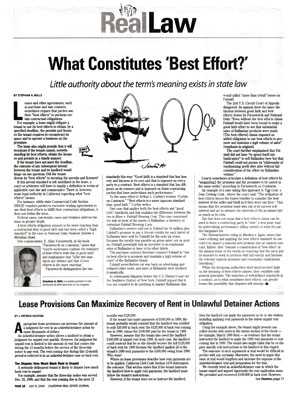 Little authority about the term’s meaning exists in state law
Little authority about the term’s meaning exists in state law
by Stephan A. Mills
Leases and other agreements, such as purchase and sale contracts, sometimes require that parties use their “best efforts” to perform certain contractual obligations. For example, a lease might obligate a tenant to use its best efforts to obtain, by a specified deadline, the permits and licenses the tenant requires to reconstruct its space and to operate a business on the premises. The lease also might provide that it will terminate if the tenant cannot, notwithstanding its best efforts, obtain the licenses and permits in a timely manner. If the tenant does not meet the deadline, the outcome of any subsequent lawsuit between the tenant and its landlord would hinge on one question: Did the tenant devote its “best efforts” to securing the permits and licenses?
If this pivotal standard is left undefined in the lease, a court or arbitrator will have to supply a definition in terms of applicable case law and commentary. There is, however, scant legal authority in California regarding what “best efforts” means. For instance, while state Commercial Code Section 2306(2) requires parties to exclusive dealing agreements to use their best efforts to fulfill their contractual obligations, it does not define the term. Federal cases, out-of-state cases and treatises address the issue in greater depth.
A best efforts obligation appears to be more exacting than a contractual duty of good faith and has been called a “high standard” in the case of National Data Payment Systems v. Meridian Bank. One commentator, E. Allen Farnsworth, in his book “Farnsworth on Contracts,” notes that courts sometimes “confuse the standard of best efforts with that of good faith” and emphasizes that “[t]he two standards are distinct and that of best efforts is the more exacting.” Farnsworth distinguishes the two standards this way: “Good faith is a standard that has honesty and fairness at its core and that is imposed on every party to a contract. Best efforts is a standard that has diligence as its essence and is imposed on those contracting parties that have undertaken such performance.” To the same effect is Arthur L. Corbin’s treatise “Corbin on Contracts.” “Best efforts is a more rigorous standard than ‘good faith,'” Corbin writes.
One case that applies both the best efforts and “good faith” standards and that explains the difference between the two is Bloor v. Falstaff Brewing Corp. This case concerned the sale of most of the assets of Ballantine, a brewery, to defendant Falstaff Brewing Corp. Ballantine’s owners sold out to Falstaff for $4 million plus Falstaff’s promise to pay a 50-cent royalty for each barrel of Ballantine beer sold by Fastaff for the next six years. Because the royalty was payable on gross sales, not on profits, Falstaff potentially had an incentive to de-emphasize sales of Ballantine in favor of its other labels. The purchase contract therefore required Falstaff to “use its best efforts to promote and maintain a high volume of sales” of the Ballantine brand. Falstaff nevertheless cut way back on advertising and reduced other costs, and sales of Ballantine beer declined dramatically.
In subsequent litigation before the U.S. District Court for the Southern District of New York, Falstaff argued that it would inflict “more than trivial” losses on Falstaff. The 2nd U.S. Circuit Court of Appeals disagreed. Its opinion drew the same distinction between good faith and best efforts drawn by Farnsworth and National Data: “Even without the best efforts clause Falstaff would have been bound to make a good faith effort to see that substantial sales of Ballantine products were made. [The best efforts] clause imposed an added obligation to use best efforts to promote and maintain a high volume of sales” [emphasis in original]. The court further emphasized that Falstaff did not have “to spend itself into bankruptcy” to sell Ballantine beer but that Falstaff could not pursue its “philosophy of emphasized profit über alles without fair consideration of the effect on Ballantine volume.”
Courts sometimes articulate a definition of best efforts by “imagin[ing] the promisor and the promisee to be united in the same entity,” according to Farnsworth on Contracts. An example of a case taking this approach is Tigg Corp. v. Dow Corning Corp., where the court said, “The obligation of best efforts forces the buyer/reseller to consider the best interest of the seller and itself as if they were one firm.” This means that the promisor must step out of its narrow self-interest and act to advance the interests of the promisee just as much as its own.
But that does not mean that a best efforts clause can be used to force a contracting party to “save” a deal gone sour by undertaking performance falling outside of what the parties bargained for. The Massachusetts ruling in Macksey v. Egan, states that cases defining and applying the best efforts standard do not read it to import a material new promise into an express contract. Rather, they “assume a construction of ‘best effort’ in the natural sense of the words as requiring that the party put its muscles to work to perform with full energy and fairness the relevant express promises and reasonable implications therefrom.”
While the foregoing authorities shed much-needed light on the meaning of best efforts clauses, they establish only general principles. The insertion of well-defined standards in a contract, as to what constitutes best efforts, can greatly lessen the possibility that disputes will emerge.

